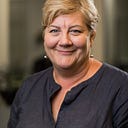Last year children and young people told me that bullying was one of the biggest issues for them and they wanted me to do something about this in my work as Commissioner for Children and young people.
It’s also a priority of the State Government with their pledge to implement anti-bullying strategies in all schools. Schools will now be asked to look at their anti-bullying policies. They will also get training on how to identify and respond to bullying. This is a positive move, but I am eager to see much more done and for children and young people to be involved in this process.
Since March I have been carrying out a series of consultations with groups of young people in years 6 to 12 in schools and in non-school settings. So far I have spoken to over 200 young people and I’ll soon be coming to the end of the consultation series. These consultations will inform a major report that I’ll be giving to parliament later this year.
We all know that bullying is a problem — it’s pervasive and affects children and young people of all ages. And what’s being done doesn’t work.
I am trying to get a better understanding of the things we don’t know. I want to know what bullying looks and sounds like in 2018 and what children and young people think causes someone to engage in these types of behaviours. By listening to children and young people about what they think might work in addressing the issue of bullying we might find better ways to prevent it from happening in the first place.
Facilitating a consultation like this needed to be considered, thoughtful and protective. We met with experts and designed a session plan that uses a fictional character to facilitate discussions. We describe the character, Jessie, as being a bully and ask participants to describe what Jessie says and does. By using Jessie we can keep the conversations safe and allow children and young people to engage in a way they feel comfortable. It’s an exercise that allows the participants to describe bullying in a way that’s not personal to them.
One of the key questions I have been asking during these consultations is what children and young people think the solutions are. I ask where bullying happens and I ask what doesn’t work. What’s interesting is that every list of what doesn’t work has been more or less the same in every group. For example walking away, telling teachers or blocking people online.
I also ask the young people to develop tool kits with ideas of what schools can do to prevent or address bullying, what parents or carers can do to prevent it and I ask what other young people can do to help. I ask lots of questions with a focus on the bully, not the bullied. It’s not an easy conversation to have. If this was easy we would be dealing with bullying in a much more effective way across the board.
I have also seen that every school is doing something different to address the problem of bullying. Solutions are a really difficult thing to come up with but the young people taking part do have some good ideas. Some have said that the library should be opened at lunchtime, some talk about a whole school buddy system, others want more organised activities when they are not in lessons.
Some early indications or learnings are that the story of Jessie is working as the children and young people can choose to engage at whatever level is comfortable to them. They understand that adults don’t understand what bullying really looks like in 2018 and they are interested in helping us find solutions. Adults put emphasis on very different things than children and young people. Overwhelmingly young people say that words do hurt them. It’s not the extremes that necessarily hurt the most but the day to day persistent, consistent put downs by other kids. Also cyber-bullying is a word they have heard but not a word they use.
What’s really interesting is that most young people have a lot of empathy for Jessie. They think Jessie might be having difficulties at home. A really important point is that most of them say that kids are not born bullies but have learn it, often from adults.
I have also found there is no difference no matter where you go north south east or west, there are differences however across age and gender. Sometimes bullying can be about difference but not always, sometimes it is about hurting others when you feel hurt? Also, the conversation needs to shift from schools to community. Young people are talking about many environments where bullying happens that aren’t schools like clubs and workplaces.
What is positive from the story so far is that children and young people are genuinely interested in being involved in developing ways to prevent bullying. There will be further consultations and analysis at the end and we will look at what programs are out there that are said to work. I hope this will make some headway in helping us reframe the conversation about bullying and go somewhere in achieving tangible solutions for the many children and young people whose lives are greatly affected by it.
Helen Connolly, Commissioner for Children and Young People SA.
Friday 25th May 2018
